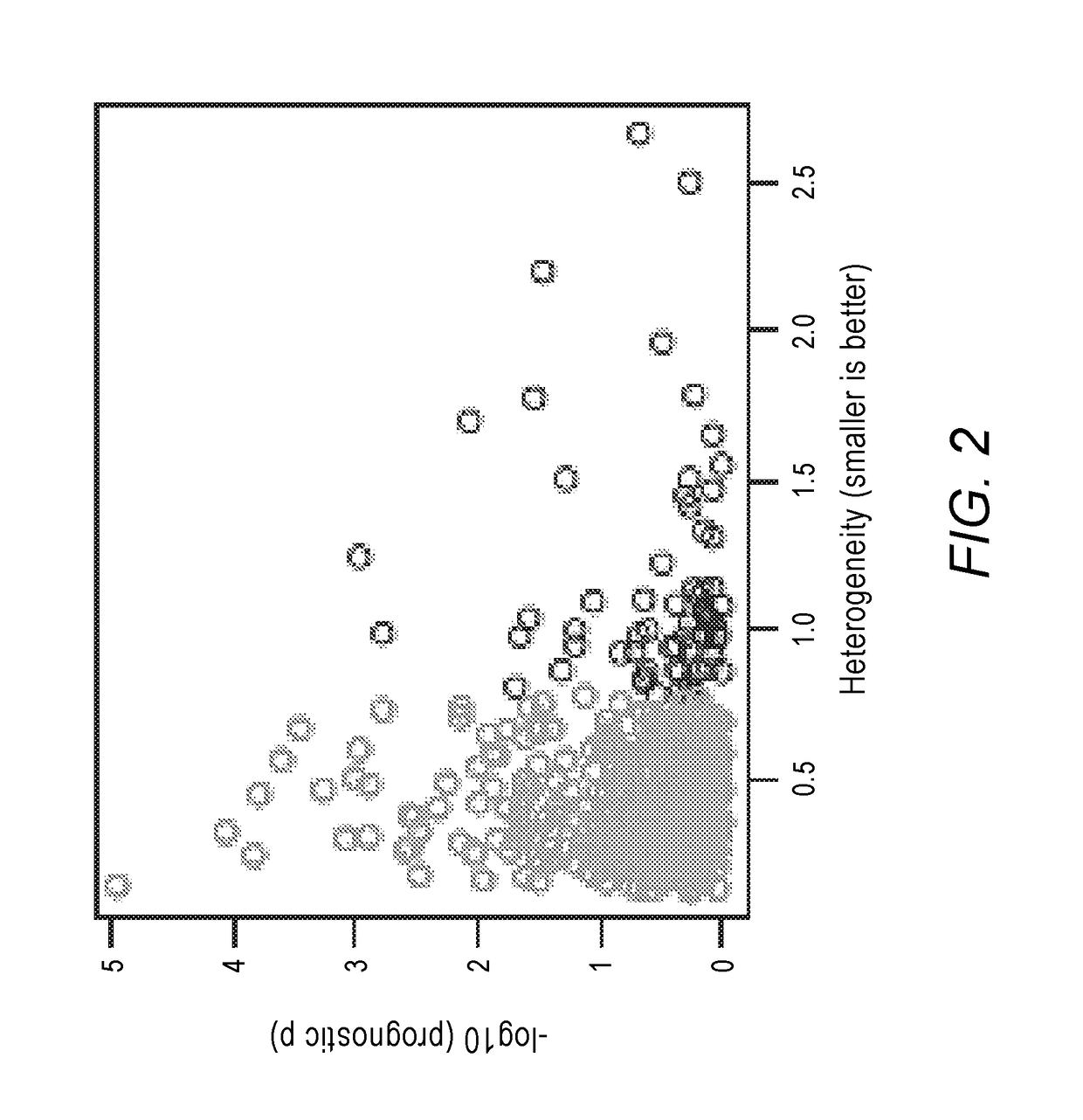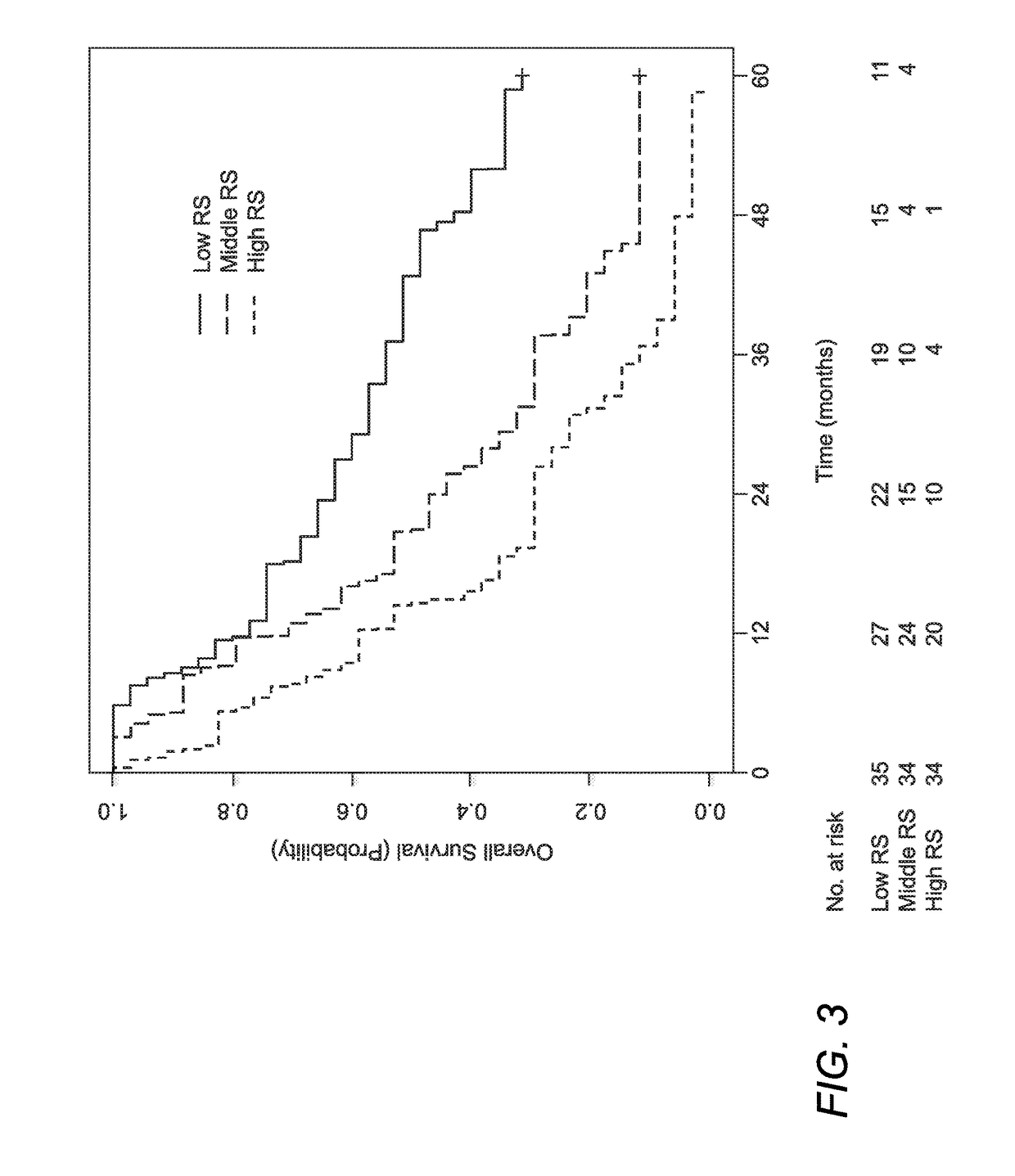Biomarker based prognostic model for predicting overall survival in patients with metastatic clear cell kidney cancer
a clear cell kidney cancer and prognostic model technology, applied in the field of renal cell carcinoma, can solve the problems of lack of studies reporting prognostic molecular signatures, limited prior studies of biomarkers from cytoreductive nephrectomies, and almost always fatal metastatic r
- Summary
- Abstract
- Description
- Claims
- Application Information
AI Technical Summary
Benefits of technology
Problems solved by technology
Method used
Image
Examples
example 1
[0194]Patients eligible for CALGB 90206 had metastatic or unresectable RCC with a clear cell histology, Karnofsky performance status ≧70%, and adequate organ function. Prior chemotherapy for metastatic disease was not permitted. A stratified random block design was used with the stratification factors of nephrectomy and number of adverse risk factors as defined by the Motzer criteria (Motzer et al., 2002, J. Clin. Oncol. 20 (1), 289-296). All details of the clinical trial are published elsewhere (Rini et al., 2008, J. Clin. Oncol. 26(33), 5422-5428 and Rini et al., 2010, J. Clin. Oncol. 28 (13), 2137-2143). Each participant signed an IRB-approved, protocol-specific informed consent in accordance with federal and institutional guidelines. Data collection and statistical analyses were conducted by the Alliance Statistics and Data Center.
RNA Extraction
[0195]Using tumors received as part of CALGB90206, H&E stains were made of samples received by CALGB and reviewed by a...
example 2
[0205]CALGB90206 enrolled 732 patients in the United States and Canada between October 2003 and July 2005. The primary outcomes from the parent trial have been previously reported (Rini et al., 2008, J. Clin. Oncol. 26(33), 5422-5428 and Rini et al., 2010, J. Clin. Oncol. 28 (13), 2137-2143). After enrollment 10 patients did not meet eligibility, 26 patients met exclusion criteria, and 16 patients refused to participate. FIG. 1 presents the REMARK diagram. Consents for use of tissue for correlative studies were obtained form 92% (676 / 732) of patients (FIG. 1). The eligibility for the parent trial required primary tumor tissue to be available. However, tissue submission was not required for patients to start treatment. Paraffin-embedded tumor blocks or unstained slides were received for 395 patients. All tissues were H&E stained and centrally reviewed by a single GU pathologist (J.S.). Cases were excluded where the tissue was from a metastatic site or the primary tumor was not a clea...
example 3
[0212]Approximately one-third of patients newly diagnosed with RCC have metastatic disease, and after treatment for localized RCC, 25-50% of patients will suffer metastatic recurrence. The survival for individual patients can vary widely. Patients can be stratified into risk groups based on readily available clinical parameters such as performance status, serum lactate dehydrogenase, hemoglobin, serum calcium, and length of time between initial diagnosis and treatment (Motzer et al., 2002, J. Clin. Oncol. 20 (1), 289-296). The number of MSKCC adverse clinical risk factors was used to stratify the randomization for the parent clinical trial of this study, CALGB 90206. Unfortunately, MSKCC adverse clinical risk factors only had modest prognostic ability in our population with a tdAUC of 0.61, demonstrating the need for developing predictive markers with higher precision.
[0213]The inventors developed a molecular prognostic signature based on 8 genes and MSKCC adverse clinical risk fact...
PUM
| Property | Measurement | Unit |
|---|---|---|
| Volume | aaaaa | aaaaa |
| Volume | aaaaa | aaaaa |
| Volume | aaaaa | aaaaa |
Abstract
Description
Claims
Application Information
 Login to View More
Login to View More - R&D
- Intellectual Property
- Life Sciences
- Materials
- Tech Scout
- Unparalleled Data Quality
- Higher Quality Content
- 60% Fewer Hallucinations
Browse by: Latest US Patents, China's latest patents, Technical Efficacy Thesaurus, Application Domain, Technology Topic, Popular Technical Reports.
© 2025 PatSnap. All rights reserved.Legal|Privacy policy|Modern Slavery Act Transparency Statement|Sitemap|About US| Contact US: help@patsnap.com



